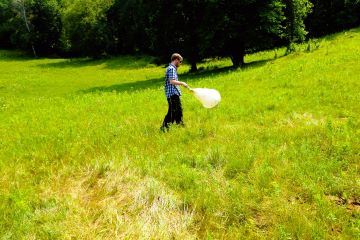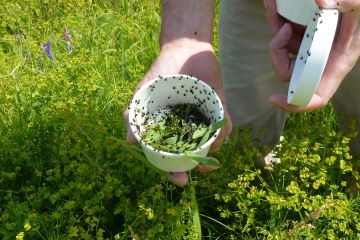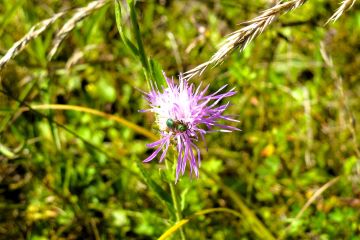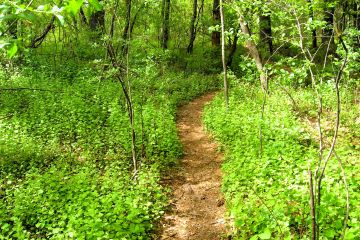- Ready-made equipment purchase (e.g., freeze dryer, refrigerator, freezer, harvester, seed cleaner, heat pump)
- Purchasing of supplies, equipment, and services to modify or build a custom piece of machinery that is not commercially available (e.g., seed cleaning trailer, elderberry destemmer, custom mechanical harvester)
- Supplies to support growing, harvesting, or processing of CLC crop and food products (e.g., electrical supplies, plumbing supplies, structures to grow or process crops)
- Consumeable goods (e.g., pots, soil amendments, water)
- Seeds and bareroot plant stock (e.g., hazelnut) purchase
- Printing of training manuals, promotional and outreach materials, and new product labels
- Infrastructure to scale production (e.g., contract for construction of large shed to store, protect, and operate processing machinery; creation/enhancement of loading pad to improve shipping and receiving; raised plant beds; greenhouse; electrical; and plumbing)
- In-state travel (mileage, lodging) to attend conferences, training sessions, meet with prospective growers, buyers, and farmers, provide outreach
- Contracts for development of specialty parts from a machinist, machine technical assistance, and equipment retrofits
- Contracts for graphic design to develop labels and packaging for new CLC products
- Contracts for pre-marketing services to find buyers and markets for crops and development of a marketing strategy, and lawyers to develop agreements with value-added companies (e.g., Kernza® grain to flour) and co-operative membership agreements
- Incentive payments to program beneficiaries for developing standard operating procedures and recipes for new products, developing logistics for new distribution systems, implementing new infrastructure and equipment for CLC crops and cropping systems, and providing technical assistance and training to new farmers
- Ready-made equipment purchase (e.g., freeze dryer, refrigerator, freezer, harvester, seed cleaner, heat pump)
- Purchasing of supplies, equipment, and services to modify or build a custom piece of machinery that is not commercially available (e.g., seed cleaning trailer, elderberry destemmer, custom mechanical harvester)
- Supplies to support growing, harvesting, or processing of CLC crop and food products (e.g., electrical supplies, plumbing supplies, structures to grow or process crops)
- Consumeable goods (e.g., pots, soil amendments, water)
- Seeds and bareroot plant stock (e.g., hazelnut) purchase
- Printing of training manuals, promotional and outreach materials, and new product labels
- Infrastructure to scale production (e.g., contract for construction of large shed to store, protect, and operate processing machinery; creation/enhancement of loading pad to improve shipping and receiving; raised plant beds; greenhouse; electrical; and plumbing)
- In-state travel (mileage, lodging) to attend conferences, training sessions, meet with prospective growers, buyers, and farmers, provide outreach
- Contracts for development of specialty parts from a machinist, machine technical assistance, and equipment retrofits
- Contracts for graphic design to develop labels and packaging for new CLC products
- Contracts for pre-marketing services to find buyers and markets for crops and development of a marketing strategy, and lawyers to develop agreements with value-added companies (e.g., Kernza® grain to flour) and co-operative membership agreements
- Incentive payments to program beneficiaries for developing standard operating procedures and recipes for new products, developing logistics for new distribution systems, implementing new infrastructure and equipment for CLC crops and cropping systems, and providing technical assistance and training to new farmers
The MDA determines the mitigation levels for the DWSMAs of community supply wells based on monitoring data provided by the Minnesota Department of Health. All areas identified with elevated nitrate begin in a voluntary Mitigation Level (Level 1 or 2), unless the MDA determines there is a point source causing the well to exceed these levels or the MDA delays the determination of a mitigation level decision for good cause. A delay for good cause would allow MDA to collect additional information such as to evaluate a potential point source that may be a significant source of nitrate in the public well.
The process for determining the mitigation level includes conducting a review of the quality of the monitoring data, the condition and vulnerability of the well, the hydrogeology and groundwater flow paths for groundwater flowing into the well, and potential point sources such as an agricultural chemical facility, septic system(s), feedlot(s) or a poorly constructed well that may be contributing significantly to nitrate levels in the well. View the current list of Mitigation Level Determinations.
Level One
Community public water supply wells (and their DWSMAs) with monitoring results of 5.4 to less than 8 mg/L nitrate-nitrogen fall under Level 1. At this mitigation level the MDA will encourage the voluntary adoption of the University of Minnesota nitrogen fertilizer BMPs and other practices which can reduce nitrate levels in groundwater such as precision agriculture, perennial crops, forages, cover crops, nitrification inhibitors, new hybrids, or taking targeted land out of production. These other practices are collectively referred to as alternative management tools or AMTs. Approved AMTs may substitute for nitrogen fertilizer BMPs.
DWSMAs at mitigation Level 1 are subject to Part 1 of the rule but are not subject to Part 2 of the rule.
Level Two
Community public water supply wells (and their DWSMAs) with monitoring results at or exceeding 8.0 mg/L nitrate- at any point during the previous 10 years, or projected to exceed the drinking water standard of 10 mg/L nitrate-nitrogen in the next ten years, will be included in Level 2.
For DWSMAs at Level 2, the MDA will work with local farmers to adopt practices that can reduce nitrate levels in groundwater. A local advisory team will be formed to include local farmers, agronomists, and others to help recommend the BMPs and AMTs that should be used. In addition, a local groundwater monitoring well network may be developed. The MDA will promote the implementation of appropriate nitrogen fertilizer BMPs and AMTs. To help facilitate AMT implementation, the MDA has worked with other agencies to make DWSMAs with elevated nitrate among the highest priority areas for state and federal funding.
The MDA will conduct surveys to assess the adoption rates of BMPs and other practices and use computer modeling to estimate the change in nitrate losses over a DWSMA. The modeling will consider the soils, crops, agricultural practices and precipitation in the DWSMA and help local farmers estimate whether changes in practices will improve water quality.
Level Three
Level 3 is the first regulatory level. A Level 2 site will progress to Level 3 if one of the following occurs: after not less than 3 growing seasons or the estimated lag time, whichever is longer, the recommended BMPs are not adopted on 80% of the cropland acres (excluding soybean acres); or the nitrate concentrations in groundwater continue to increase; or, after not less than three growing seasons the residual soil nitrate below the root zone increases. The estimated lag time is the time it takes for changes in practices to have an effect on groundwater quality or on the public well with elevated nitrate. This time may vary significantly based on the local soils, hydrogeology and actual precipitation. Computer modeling and groundwater age estimates can be used to determine the estimated lag time. Residual soil nitrate testing below the root zone is a more difficult process of testing nitrate levels in soil. It is used to determine if nitrate is increasing or decreasing over time and may be used in locations with very long lag times.
The Commissioner of Agriculture – in consultation with a local advisory team – would then require landowners to implement actions such as BMPs, soil testing, record keeping, and educational programs. The Commissioner may delay moving to a regulatory level if computer modeling indicates that the adopted practices are going to be effective in reducing nitrate levels below 8 mg/L.
Level Four
Level 4 is the second regulatory level. If nitrate-nitrogen in the public water supply well exceeded 9 mg/L for any three samples in the previous 10 years; or after three years the residual soil nitrate below the root zone increases; or after three years or the estimated lag time, whichever is longer, the nitrate levels continue to increase, then the DWSMA would be given a Level 4 designation. The Commissioner of Agriculture – in consultation with a local advisory team – could require landowners to implement additional practices beyond best management practices. These practices would be determined on a site-specific basis following guidance outlined in MN Statutes Chapter 103H.275 Subd. 2(a). However, they shall not include restrictions on the primary crop or require fertilizer rates below the low end of the University of Minnesota recommended fertilizer rate range.
DWSMAs will be monitored and will move up or down a mitigation level according to changes in water quality. DWSMAs may only move up one mitigation level at a time. For example, a DWSMA will never go from Level 1 to Level 3 in a single cycle.
If you are sending a sample to a certified lab, follow instructions provided by the lab. The instructions below are for collecting a sample to take to your local SWCD or county Environmental Services office or to a local nitrate testing clinic.
To take your sample, run your cold water tap for five to ten minutes then collect about one cup of water in a plastic baggie (double bag) or clean jar. Keep the water cool until arrival. You can collect the water anytime within one day of the nitrate analysis.





